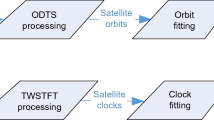Abstract
Geostationary (GEO) satellites form an indispensable component of the constellation of Beidou navigation system (BDS). The ephemerides, or predicted orbits of these GEO satellites(GEOs), are broadcast to positioning, navigation, and timing users. User equivalent ranging error (UERE) based on broadcast message is better than 1.5 m (root formal errors: RMS) for GEO satellites. However, monitoring of UERE indicates that the orbital prediction precision is significantly degraded when the Sun is close to the Earth’s equatorial plane (or near spring or autumn Equinox). Error source analysis shows that the complicated solar radiation pressure on satellite buses and the simple box-wing model maybe the major contributor to the deterioration of orbital precision. With the aid of BDS’ two-way frequency and time transfer between the GEOs and Beidou time (BDT, that is maintained at the master control station), we propose a new orbit determination strategy, namely three-step approach of the multi-satellite precise orbit determination (MPOD). Pseudo-range (carrier phase) data are transformed to geometric range (biased geometric range) data without clock offsets; and reasonable empirical acceleration parameters are estimated along with orbital elements to account for the error in solar radiation pressure modeling. Experiments with Beidou data show that using the proposed approach, the GEOs’ UERE when near the autumn Equinox of 2012 can be improved to 1.3 m from 2.5 m (RMS), and the probability of user equivalent range error (UERE)<2.0 m can be improved from 50% to above 85%.
Similar content being viewed by others
References
Zhou S S, Hu X G, Wu B. Orbit determination and prediction accu racy analysis for a regional tracking network. Sci China-Phys Mech Astron, 2010, 53: 1130–1138
Zhou S S, Hu X G, Wu B. Orbit determination and time synchronization for a GEO/IGSO satellite navigation constellation with regional tracking network. Sci China-Phys Mech Astron, 2011, 54: 1089–1097
Guo R, Hu X G, Tang B, et al. Precise orbit determination for geostationary satellites with multiple tracking techniques. Chin Sci Bull, 2010, 55: 687–692
Huang Y, Hu X G, Huang C, et al. Precise orbit determination of a maneuvered GEO satellite using CAPS ranging data. Sci China Ser G-Phys Mech Astron, 2008, 38: 1750–1758
Li Z G, Yang X H, Ai G, et al. A new method for determination of satellite orbits by transfer. Sci China Ser G-Phys Mech Astron, 2009, 52: 384–392
Zhou S S. Studies on Precise Orbit Determination Theory and Application for Satellite Navigation System with Regional Tracking Network (in Chinese). Shanghai: Shanghai Astron Obs, 2011. 19–69
Guo R. Studies on Precise Orbit Determination for the COMPASS Navigation Satellite (in Chinese). Shanghai: Shanghai Astronomical Observatory Chinese Academy of Sciences, 2010: 36–41
Carlos J, Urs Hugentobler, Peter S. Precise GNSS orbit determination using an adjustable box-wing model for solar radiation pressure. IUGG Melboume, July 2011: 1–21
Yoaz E. A New Model for GPS yaw attitude. J Geodesy, 1996, 70: 714–723
Montenbruck O. ANTEX Considerations for Multi-GNSS Work. Antenna WG Meeting, IGS Workshop, July 2012: 1–32
Dayne G C. Solar radiation pressure modeling issues for high altitude satellites. Faculty department of Aeronautics and Astronautics graduate school of engineering and management air force institute of technology air university, 2001. 50–89
Bar-Sever Y, Kuang D. New Empirically Derived Solar Radiation Pressure Model for Global Positioning System Satellites. IPN Progress Report, 2004. 1–11
Liu L, Zhu L F, Han C H. The model of two-way radio time transfer between the earth and satellites and analysis of its experiment. Acta Astron Sin, 2009, 50: 189–196
Liu L, Han C H. Two way satellite time transfer and its error analysis. Prog Astron, 2004, 22: 219–226
Imae M. Development of new time transfer modem for TWSTFT. In: Proc of ATF 2000, 2000. 164–167
Li X J. Studies on Precise orbit determination and prediction for the regional navigation satellite (in Chinese). PLA Information Engineering University, 2012. 41–48
Author information
Authors and Affiliations
Corresponding author
Additional information
Recommended by LIAO XinHao (Associate Editor-in-Chief)
Rights and permissions
About this article
Cite this article
Li, X., Zhou, J., Hu, X. et al. Orbit determination and prediction for Beidou GEO satellites at the time of the spring/autumn equinox. Sci. China Phys. Mech. Astron. 58, 89501 (2015). https://doi.org/10.1007/s11433-015-5675-6
Received:
Accepted:
Published:
DOI: https://doi.org/10.1007/s11433-015-5675-6




